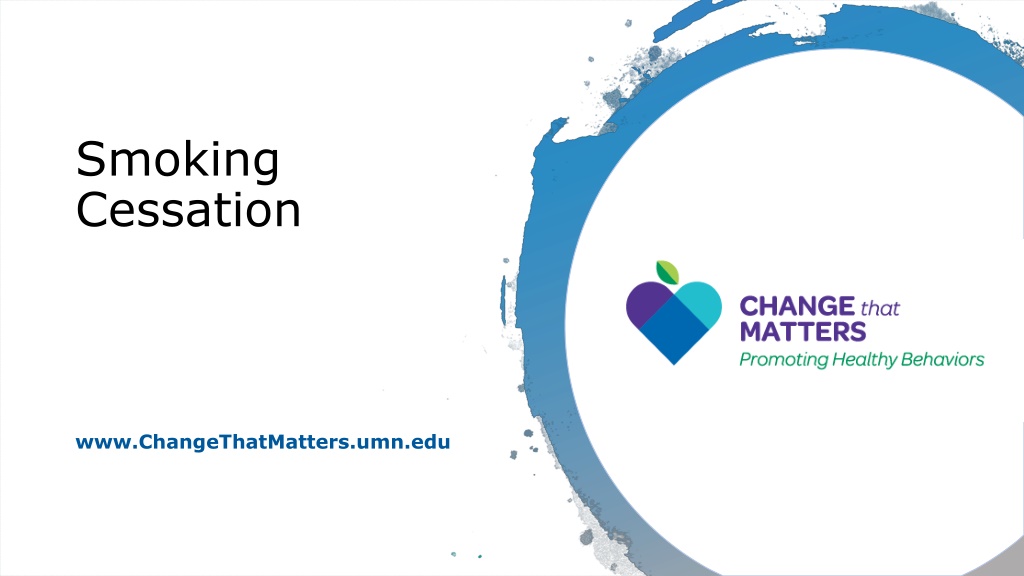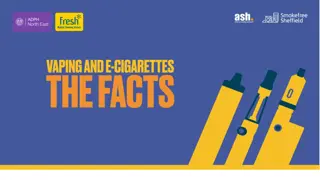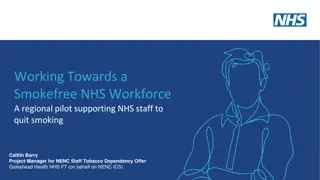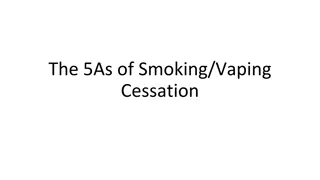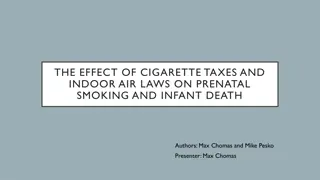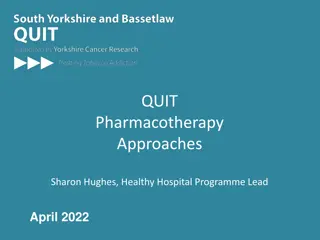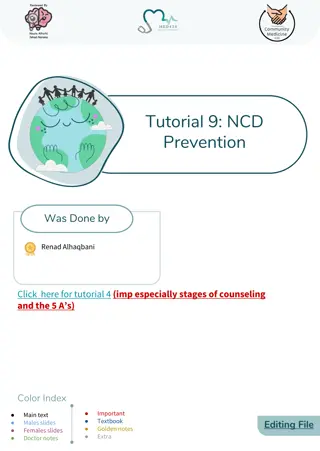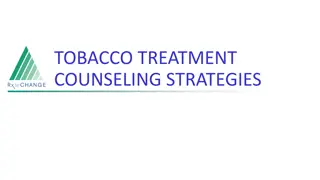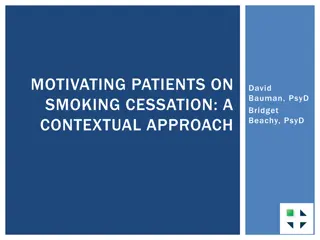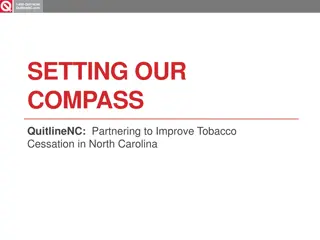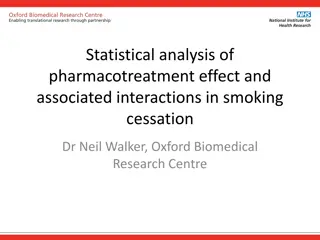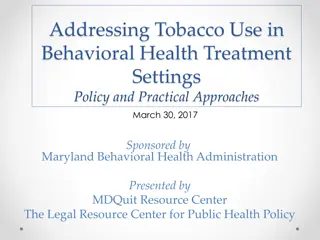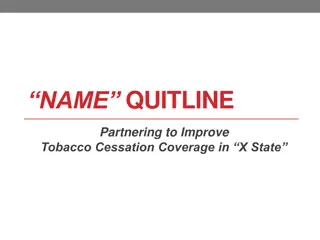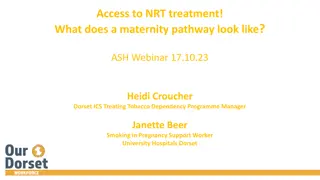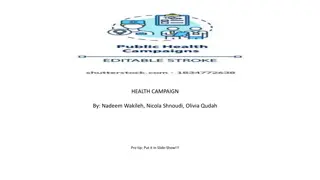Smoking Cessation: Strategies and Interventions
Smoking cessation is crucial for improving overall health, with about 15% of adults still smoking despite known risks. Quitting is challenging, but evidence-based treatments like brief interventions and combination therapy have shown effectiveness. Healthcare professionals can follow a structured approach to assist smokers in their journey to quit, starting with screening and personalized advice. Motivational interviewing plays a key role in promoting motivation and autonomy.
Download Presentation

Please find below an Image/Link to download the presentation.
The content on the website is provided AS IS for your information and personal use only. It may not be sold, licensed, or shared on other websites without obtaining consent from the author.If you encounter any issues during the download, it is possible that the publisher has removed the file from their server.
You are allowed to download the files provided on this website for personal or commercial use, subject to the condition that they are used lawfully. All files are the property of their respective owners.
The content on the website is provided AS IS for your information and personal use only. It may not be sold, licensed, or shared on other websites without obtaining consent from the author.
E N D
Presentation Transcript
Smoking Cessation www.ChangeThatMatters.umn.edu
Prevalence About 15% of adults smoke cigarettes Substantial reduction from the 1960 s (about 44%) Tobacco dependence is considered a chronic disease that requires repeated interventions and efforts to quit
The risks of smoking are well- known Smoking affects nearly every body system
Quitting is hard! 70% of US smokers say they want to quit 44% try to quit each year 4-7% are successful on their own
Treatments Brief interventions of 1-3 min have been shown to be effective (rates of cessation = 14.4%) Combination of pharmacotherapy and behavioral counseling is the gold standard of treatment
Step 1: Ask About Smoking Screen all patients for tobacco use Ask about current use and past quit attempts
Step 2: Advise to Quit Be clear: It is important that you quit smoking now, and I can help you. Be strong: As your physician, I need you to know that quitting smoking is the most important thing you can do to protect your health now and in the future. Be personalized: Continuing to smoke makes your asthma worse, and quitting could dramatically improve your health.
Step 3: Assess Willingness to Quit Are you willing to give quitting a try? Yes: Go to Step 4 No: Go to Step 3a
Step 3A: Motivational Interviewing Explore importance How important is it for you to quit smoking? Promote Motivation Normalize concerns It s hard to quit smoking. Support autonomy I hear you saying you are not ready to quit right now. I m here to help when you are ready.
Step 3A: Motivational Interviewing Highlight discrepancy between behavior and patients values/goals. It sounds like you are very devoted to your family. How does your smoking affect your children? Develop Discrepancy Support change talk You realize that smoking affects your breathing and makes it hard to keep up with your kids.
Step 3A: Motivational Interviewing Back off Sounds like you are feeling pressured about your smoking. Roll with Resistance Empathize You are worried about how you would manage withdrawal symptoms. Ask permission Would you like to hear some strategies that can help you address that concern when you quit?
Step 3A: Motivational Interviewing Identify and build on past successes. You were able to stay off cigarettes for 2 months last time you quit! Support Self- Efficacy Offer options for small change steps Calling the Quitline Reading about quitting benefits and strategies Changing smoking patterns (not smoking in the house)
5 Rs Relevance: Why is quitting smoking personally relevant to the patient? Risk: Advise about negative consequences about continuing to smoke. Rewards: Identify benefits of quitting smoking. Roadblocks: Identify barriers to quitting. Repeat: Continue to address at every visit.
Step 4: When ready to quit: Assist Set a quit date (ideally within 2 weeks) There is no evidence that gradually cutting back is easier than quitting all at once Tell family, friends, and coworkers about quitting, and request understanding and support Anticipate challenges Remove tobacco products from the environment Avoid smoking in places you spend a lot of time Make home smoke-free
Step 4: Assist With Quitting Offer medication: first line Buproprion SR Nicotine gum Nicotine inhaler Nicotine lozenge Nicotine nasal spray Nicotine patch Varenicline
Step 4: Assist With Quitting Practical counseling approaches (in handout) Provide social support Provide supplementary resources QuitPlan (1-800-QUIT-NOW) Referral to behavioral health [BH] or pharmacy if needed (BH can help with stress management, if that is a major barrier to quitting)
Step 5: Arrange Follow-up within 1 week Visit goals: Congratulate those who have been abstinent on their success For those who have smoked, review circumstances and look for recommitment Identify problems encountered Assess medication use and problems Review support options Arrange for a second follow-up visit within the first month
Change That Matters Focus on Values/Meaning in Life
Connect Quitting Smoking to Life Meaning and Purpose Invite patient to reflect upon: Why do you want to make this change? How will quitting smoking impact your life? How will this change allow you to engage in other, meaningful areas of your life?
Noteworthy Features Handout encourages reader to: Reflect on personal reasons to quit smoking Tie quitting smoking to values Consider readiness to quit Define barriers to quitting Set quit date Identify triggers and define plan to cope with them Consider who could help
Documentation Template Assess: Currently smokes/uses: *** type/amount Previous attempts to quit: *** Barriers to quitting: {Stress management, Habit, Social benefit, Nicotine addiction, Family/friends smoke, Other) Reasons to quit smoking: {Health, Mood, Family, Friends, Self-worth, Appearance, Save money, More energy, Other) Family/friends who can offer support: *** Advise: Quitting smoking is the most important thing you can do to improve your health now and in the future. Willing to quit now?: YES/NO
Documentation Template (cont.) Plan: Ask patient to write specific goal on back page of handout Quit date: *** Medications prescribed: *** Follow up (preferably within 1 week of quit date) *** Change that Matters Quitting Smoking handout given. *** minutes spent counseling patient regarding quitting smoking to improve overall health.
After Visit Summary (AVS) Template Today we talked about quitting smoking. This can be tough, but is one of the BEST things you can do for your health! You stated you want to ***. To do this, you plan to ***. Here are some helpful tips for quitting smoking: Set a goal to quit completely. Think about past quit experiences. Anticipate triggers or challenges. Limit alcohol while you are trying to quit. Limit contact with other smokers. Consider joining the QuitPlan (1-800-QUIT-NOW) or online resources like www.SmokeFree.gov
Practice Activity Partner with someone near you One person will be the patient One person with be the provider Think of a patient on your panel that you would like to quit smoking. Imagine him/her for the role play. Using the pamphlet and EHR template, role play the discussion. Take about 5 minutes and then switch roles
But Doc. I ve tried many times in the past... I just start smoking again! It usually takes several quit attempts to stop for good. Every day you don t smoke is a positive step.
But Doc. I m too stressed to quit! Smoking helps me relax. Smoking is a habit. It s perhaps your primary way to cope with stress. Would you be open to trying other ways of managing stress?
Resources SmokeFree.gov https://smokefree.gov/ Fiore, M. C., Ja n, C. R., Baker, T. B., Bailey, W. C., Benowitz, N. L., Curry, S. J., ... & Henderson, P. N. (2008). Treating tobacco use and dependence: 2008 update. Rockville, MD: US Department of Health and Human Services. For Clinicians. Content last reviewed October 2019. Agency for Healthcare Research and Quality, Rockville, MD. https://www.ahrq.gov/prevention/guidelines/tobacco/clinicians/ index.html
Change That Matters Team Stephanie A. Hooker, PhD, MPH (co-PI) Michelle D. Sherman, PhD, ABPP (co-PI) Katie Loth, PhD, MPH Kacey Justesen, MD Sam Ngaw, MD Marc Uy, BA, MPH Jean Moon, PharmD, BCACP Andrew Slattengren, DO Anne Doering, MD
Special Thanks University of Minnesota Academic Health Center and National Institute for Integrated Behavioral Health for financial support for their development and evaluation of Change that Matters
